
While few outsiders know what goes on inside an Aurum hall, the existence of the organization is no secret; most members proudly wear the eight rings of their concord. If you asked a member of the Aurum to describe it, they’d say that it’s a fraternal order with a hall in every major city in the Five Nations. They’d brag about how the Aurum strengthens local communities through philanthropy and charitable work. They’d call out that the Aurum is an organization where people with different political and religious beliefs can set those differences aside and talk as friends: that it’s an organization for people who want to make a difference in the world, who can reach beyond class and nation. However, at the end of the day few can argue that one practical purpose of the organization is to increase the wealth and power of its members. Friends do favors for friends—and everyone’s friends in the Aurum. You have a problem with the Sharn Watch? Let’s have a drink with Commander Yorgan and see if we can work something out.
Push farther, and some concordians will acknowledge that one of the founding principles of the Aurum is that the existing system within Khorvaire is oppressive: the dragonmarked houses have tyrannical economic monopolies and the monarchies of the Five Nations are outdated. The Aurum brings together the finest and most capable people outside that structure, and helps them to achieve the opportunities they deserve. Now, you may have heard rumors of a “Shadow Cabinet” that seeks to tear down the houses or overthrow monarchies, but that’s just ridiculous. The Aurum is a social club. Last night we had a delightful performance from the Diva Laria. Provost Salar gave an impromptu lecture on the Sulat League and Councilor Evix discussed a Xen’drik expedition they’re funding. No one tried to conquer the world.
Anyone who’s read the sourcebooks knows that—spoiler alert—the Shadow Cabinet DOES exist. But the important point is that most members of the Aurum itself don’t actually know that. The Aurum is what it appears to be: an alliance of wealthy and influential people who enjoy each other’s company and who use their wealth and influence to help each another. Sure, many are evil in alignment, and those people are especially likely to take advantage of the connections offered by the Aurum to strengthen their positions and gain power, even if this circumvents the law or steals those opportunities from others. But there are concordians who are truly good, who do seek to use the Aurum’s influence to strengthen the local community. And many are squarely neutral, enjoying the camaraderie of the society and happy to help their fellow concordians where they can, but having no grand aspirations of their own.
So there’s a few roles an Aurum concordian can serve in a story.
- Patron. Are you looking for someone who wants to fund an expedition? Someone who wants to pay a group of adventurers to do something that doesn’t quite fall within the law but isn’t entirely criminal, either? This is the role of the concordian. They have gold, and they have enough connections to arrange for watch patrols to be light around the entrance to Old Sharn, or to get you past customs when you land with contraband artifacts. But they don’t have the resources of a dragonmarked house or a spy agency; they need adventurers to run their errands. And these tasks don’t have to shake the world or threaten the city. A concordian may simply be indulging a personal (perhaps slightly illegal) hobby: adding to their collection of (contraband) Sulat elemental seals, or taking actions to humiliate a professional or social rival. Concordians are people who have enough wealth and power to be able to hire and help adventurers—but not so much power that adventurers become irrelevant.
- Rival. If adventurers get on the wrong side of a concordian, it can cause a lot of trouble for them… but still, not as much trouble as making an enemy of a dragonmarked house or the King’s Citadel. A concordian may have wealth and they will certainly have contacts, but especially if they’re in the lower concords there’s a limit to how many favors they can call in. Consider Ambrose Jakis in The Name of the Wind; he’s a perfect example of how an Aurum conordian could make trouble for an adventurer who’s earned their ire. To a lesser extent, a concordian could serve as a patron for a rival group of adventurers, who thus get a lot of unfair advantages because of the wealth and influence of their patron.
- Member. A player character could be given a chance to JOIN the Aurum. An existing member (perhaps a patron) would have to sponsor them, and they’d begin in the Copper Concord. As such, they wouldn’t have a lot of pull right away—but if they do favors for concordians, others will do favors in return. They may receive opportunities they’d never have gained on their own, and have access to gossip and secrets they’d never have been able to learn. It’s a great opportunity… but they will be expected to do favors for the higher ranking concordians.
But what about the Shadow Cabinet?
From a design perspective, the Aurum is designed to be an easy source of patrons and rivals. The connections of the Aurum make a concordian a dangerous enemy or a powerful ally, but part of the point of the Aurum is that it’s NOT a tightly knit conspiracy; members have to pay for favors with favors, and there are members of the Aurum who aren’t friends with one another. It’s not as tightly knit as the Dreaming Dark or even as a dragonmarked house. It’s a quick source of influential figures, but these are people low-level adventurers can deal with.
But what about the Shadow Cabinet? This follows the idea of the Illuminati or SPECTRE: an hidden organization of powerful people who intend to shift the balance of power. Members of the Shadow Cabinet ARE more tightly connected, and do freely share resources—making them far more dangerous than just an individual Silver Concordian. They want to disrupt or control monarchies, to break the power of the dragonmarked houses; a DM who wants a dramatic twist could reveal that the Shadow Cabinet was responsible for the Shadow Schism that divided House Phiarlan (whether working with or framing the Paelions)—and that they are now actively encouraging the rivalries between the three Cannith factions, hoping to permanently split that house as well. One might well say “If I want a plutocratic villain, why not just use a dragonmarked house? They seem to have more power and cooler gimmicks.“ And that’s correct: the houses DO have far more power. The point of the Shadow Cabinet is that they ARE the upstarts and the underdogs—that they are FIGHTING the established great powers of the monarchies and houses. For all his wealth and power, Antus ir’Soldorak still needs Lyrandar excoriates to fly his grand airship. He doesn’t have all the power he wants: which is why he’s fighting to disrupt the Twelve. This is a struggle that will surely take decades to bear meaningful fruit. Again, it’s possible that the Shadow Schism was a great victory for the Aurum, and that took place 26 years ago. I don’t expect the Shadow Cabinet to have any chance to actually take over the world in the course of campaign; if they COULD somehow destroy the dragonmarked houses in a year, Khorvaire would collapse into chaos. The power is that they are trying. They are working to disrupt the order, to turn houses against one another, to fund innovations that would reduce their power. They are actively trying to shake the status quo, and this can drive the events of an adventure. But their role in the story is to be the disruptive underdogs, not to actually be on top. With that said, a very important point that differentiates the houses and the Shadow Cabinet is that a dragonmarked hosue has massive power and influence within a single field. The Shadow Cabinet has agents spread across society, in places the houses can’t touch. They have concordians in the military, in the judiciary, in the arts. Their power is less CONCRETE than that of the houses, but it is more subtle; a concordian customs inspector can cause a lot of trouble for local house operations!
Hearing all of this raises an interesting option: the Shadow Cabinet COULD be presented in a heroic light. The dragonmarked houses DO wield oppressive monopolistic power. The monarchies of the Five Nations could be seen as outdated. It is entirely possible to present the Shadow Cabinet as a heroic alliance that is trying to make change—that is fighting to help the artificer working on an airship that anyone could pilot, or to push democracy in the Five Nations. By default, canon presents the Shadow Cabinet as being driven by purely selfish goals: it doesn’t actually want to make the world a better place, it wants to make it a better place for members of the Shadow Cabinet. But it is entirely possible to present it in a more altruistic light. And the reason I’m saying this with no spoilers is because, as a player, you don’t know what your DM is doing with them. When you spot someone wearing eight rings, you know they’re in the Aurum. But are they secretly plotting to throw the Five Nations into chaos? Are they fighting a secret battle in pursuit of economic innovation and democracy? Or are they a casual member who just enjoys a good game of Conqueror at the club? And as a DM, if you want to maintain that mystery, the point is to use concordians in those different capacities. Have the adventurers benefit from Aurum philanthropy. Have them need to protect an orphanage that was built with Aurum donations. When the concordian comes to them with a seemingly innocent job, is it exactly what it appears to be… or could it be serving a hidden agenda? W
Who’s In The Aurum?
The common impression is that the Aurum is an alliance of the wealthy and powerful, because it’s those wealthy and powerful members who attract attention. And usually by the time someone is in the Gold or Platinum Concords they will be wealthy or powerful… but they may not have started out that way. The Aurum doesn’t look for wealth: it looks for influence and potential. The Copper Concord includes people who don’t have power yet—but their sponsor sees a way that they could, if the right strings are pulled. Officers in the military or the watch. Civic officials. Up and coming artists. Promising artisans. The further up you go, the more wealth and influence the concordian is likely to have. They’re not a watch officer, they command a district garrison. They aren’t an aspiring playwright, they’re an international sensation. Or they could be a wealthy collector of rare Sarlonan antiquities—but if they’re in the Gold or Platinum Concords, they will be VERY wealthy…
The Aurum Concordian table provides a quick way to generate a random concordian. You’ll have to establish the basic details—this concordian is an old Brelish dwarf—but the table helps to establish that he’s an ambassador who profited off the Last War and has close ties to the Brelish military. These are basic prompts, and it’s up to you to decide how he profited off the war, or what those close ties are like—does he have personal sway with a single military unit (he can call on the Redcloak Battalion in Sharn) or does he have broader ties to Brelish military leadership?
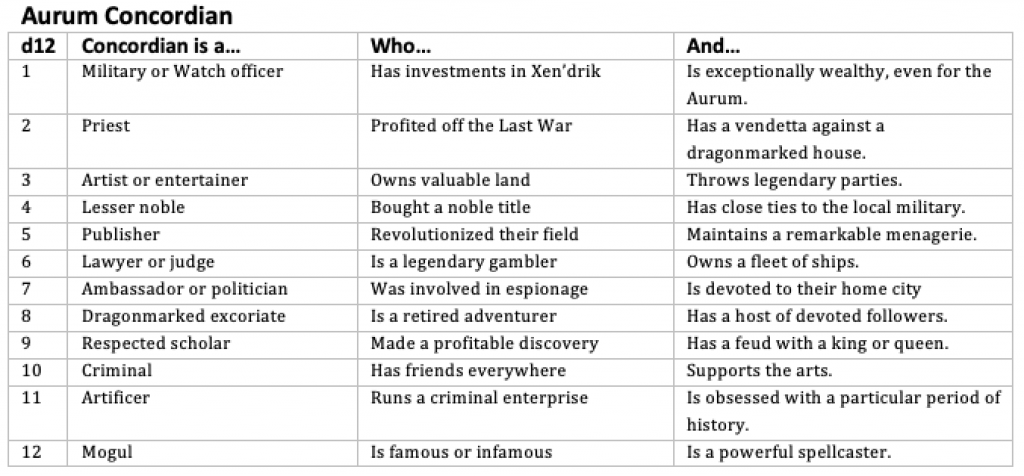
To be clear, the Aurum seeks to shake the status quo and thus tends to reject members who are powerful nobles or well-placed dragonmarked heirs. However, a concordian could be from a lesser noble family (a minor Lhazaar prince), or as in the case of Antus ir’Soldorak, could have bought a noble title. Likewise, concordians won’t include members of powerful dragonmarked families, but they can include excoriates or members of families that have fallen into disfavor and are unhappy with the Twelve… and the Aurum includes many people who run businesses licensed by the houses, but who aren’t tied to the house by blood and chafe under its yoke.
So again, an Aurum concordian can be a useful patron, a dangerous rival, someone seeking to help strengthen their community or someone determined to increase their own power at all costs. Invoking the Aurum is a quick way to establish that someone has wealth and influence… but it shouldn’t automatically establish someone as a VILLAIN. The Aurum is intended to be a source of easy foes for low-level adventures, but it can be just as useful as a source of patrons. In the novel The City of Towers, the down-on-their-luck adventurers turn to a member of the Aurum for work. And while concordians COULD turn to organizations like the Boromar Clan, House Tarkanan, or House Deneith, some members prefer not to deal with actual criminals or economic rivals… and that’s where adventurers come in!
What’s Your Connection?
The table above is a quick way to generate a random concordian. But perhaps you want an adventurer to have a concrete connection to that character. The following tables (originally posted in this article) help with that. It turns out that one of the adventurers was childhood friends we the ambassador, and that the ambassador pulled strings a year ago to get them out of jail… but now the ambassador is being targeted for assassination and they’re calling in that favor. The Aurum Concordian table takes the place of the “Aurum Member” table below, but I’m leaving that column in below, as it gives some quick and concrete examples.
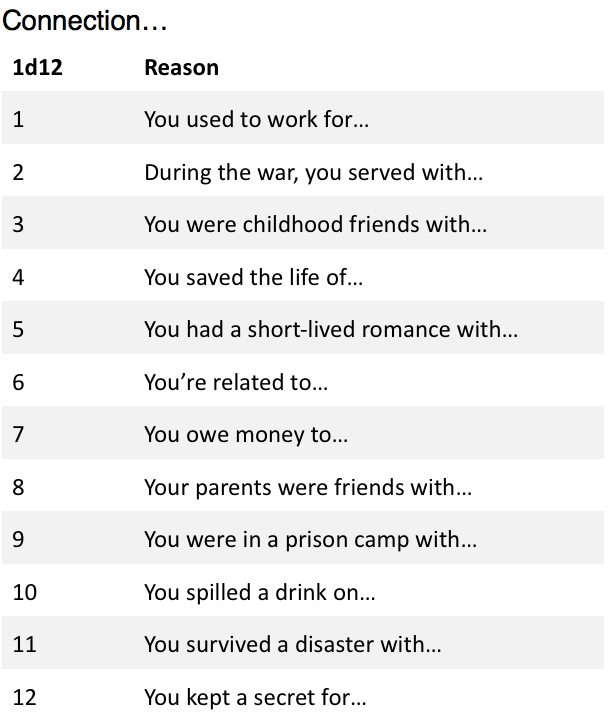
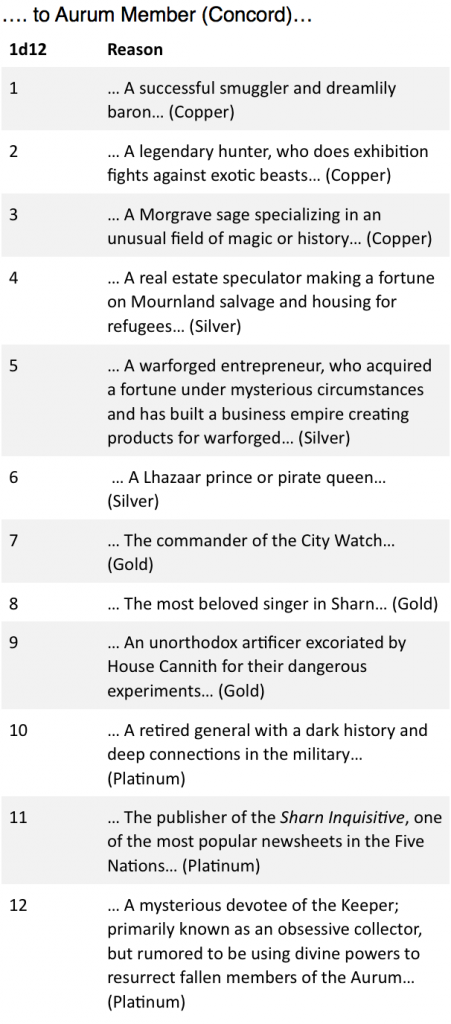
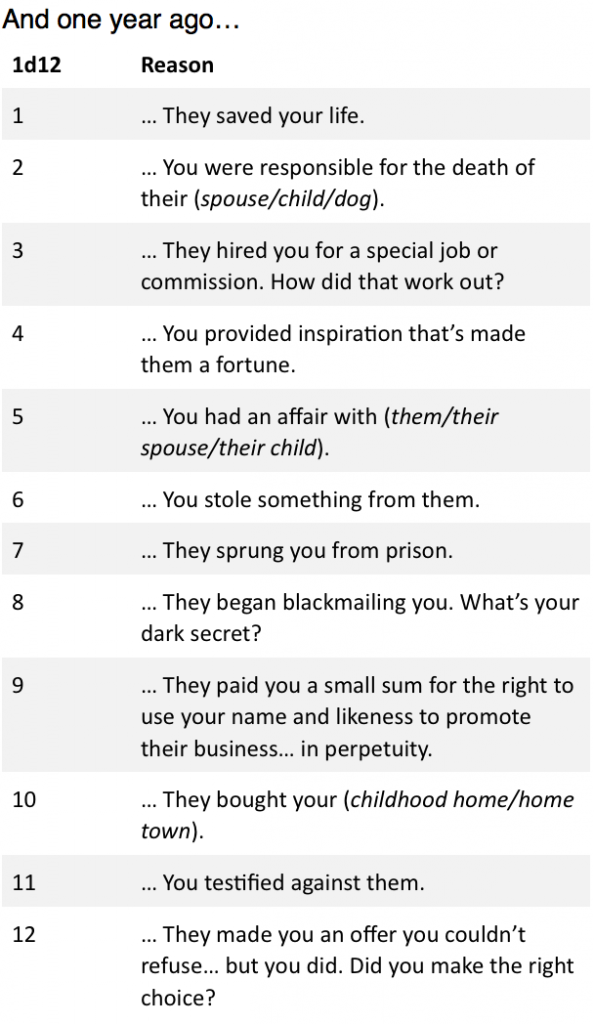
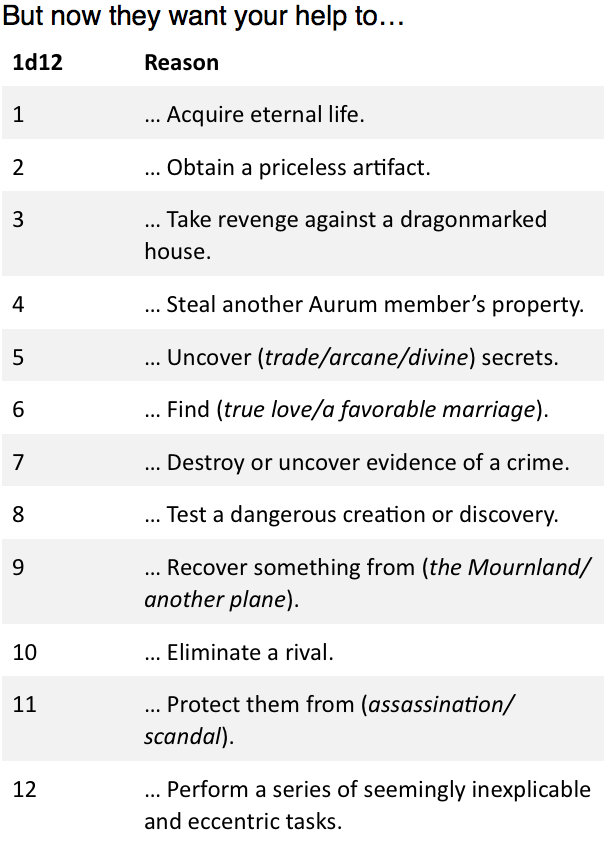
General Q&A
Does a member of the Copper Concord who’s also in the Shadow Cabinet outrank a member of the Gold Concord who’s not in the Cabinet?
The Shadow Cabinet—if it even exists!—is a secret even to members of the Aurum. So no, the copper concordian can’t make demands of the gold concordian, because the gold concordian doesn’t recognize their authority. However, the people IN the secret society work more closely together than most members of the Aurum. So a member of the Platinum Concord may go out of their way to help the copper, in a way that seems unusual—because both are in the Shadow Cabinet, and it serves the purposes of the Cabinet. But it’s always possible a DM could decide to use the Aurum WITHOUT the Shadow Cabinet… or they could decide that there’s no difference between the two, and that all members of the Aurum pursue the goals of the Cabinet.
Is there an initiation ceremony or ritual involved with joining the Aurum? If so, what is that like?
Like most fraternal orders, the Aurum undoubtedly has a vast number of secret ceremonies and rituals. What are they like? SECRET. This is a level of detail you’re not likely to ever see in canon because we could easily write an entire book about the rituals of the Aurum, but for most campaigns it will never matter. Should the adventurers ever happen to witness an Aurum initiation, you can invent the rituals or even ask your players to suggest details. But certainly, it’s a solemn, complicated ceremony and it likely involved swearing oaths under a zone of truth.
When someone joins the Aurum, they join a particular hall. We use the concord rank (gold, silver, etc) as a general indicator because it’s all that most adventurers will ever have to deal with, but you can be sure that there are a vast number of internal honors and titles used within a hall. Someone’s not just a gold concordian, they’re a “Faithful Warden of the Gold Concord” —which is itself a step up from being an “Honored Initiate of the Gold Concord.” The one that matters most is the Keeper of the Hall, who is the ultimate local authority (and almost always a member of the Platinum Concord). While I’m not going to try to suggest all the secret rituals that go on as part of initiation or advancement, I will say that in either case the initiate receives the eight rings of their concord and they also receive a concordian’s coin of the metal of their concord. The rings are produced locally; every hall has their own variation on the basic design, but they are mundane metal. A concordian’s coin is a magic item produced by the Soldorak Mint. The coin has the Aurum seal on one face (the chained crown) and a profile on the other (see below). A concordian’s coin has the following properties.
- The coin is initially unbound. When someone holds the coin in the fist and recites a specific oath, the coin is bound to that person; the only way to break this bond is to destroy or disenchant the coin. Initially, the profile on the face of the coin is a blank silhouette. When the coin is bound, it takes on the appearance of the person it’s bound to.
- Only the person the coin is bound to can hold the coin. Anyone else who touches it will receive an unpleasant arcane shock. This doesn’t cause permanent damage, but if someone picks up or holds a concordian’s coin they must make a DC 10 Wisdom save each round to keep from dropping it.
- The person the coin is bound to can use it as an arcane focus. It can also be used as a holy symbol by a cleric of the Sovereign Host (specifically Kol Korran or the Keeper).
- A concordian’s coin is a common magic item. Coins of the gold and platinum concords often carry additional enchantments; a concordian’s coin might be enchanted to serve as an amulet of proof against detection and location, for example.
Beyond this, there is also a series of protocols involving both coins and rings. For example, when shaking hands on first meeting, a concordian will tap a particular finger against the finger of the other concordian, who will answer with a different tap based on the respective ranks of the members. Likewise, at a meal between concordians they may place their coins on the table; placing them in certain configurations (crown up, to the left of a drink) can convey hidden messages.
How distinctive are the rings and coin of an Aurum concordian?
Each hall has a unique ring design. However, these rings are pure metal and the designs aren’t so complex; part of the point of the ring is that another ring can be easily worn above it (like many engagement rings). So Aurum rings wouldn’t be that hard to fabricate, especially if the people you’re dealing with aren’t familiar with the hall designs. The coin is another matter. Each one is unique to the bearer, and if someone is familiar with the Aurum and has any doubts about your identity, one of the first things they’ll do is touch your coin to see if they get a shock. All concordian’s coins are made at the Soldorak Mint; counterfeiting one isn’t just about craftsmanship, it’s about calibrating the shock to feel like the Solodrak shock. It’s something a capable artificer with proficiency in forgery could accomplish, but it’s not a trivial thing. Of course, all of this comes to the question of if you’re trying to fool a member of the AURUM. Most people don’t even know concordians carry coins, let allow that they’ll shock you.
Would the Aurum take action against someone falsely claiming to be a concordian?
ABSOLUTELY. This is a highly exclusive organization of rich and powerful people. They will NOT take kindly to people seeking to profit off their reputation. Of course, they have to find out about the hoax to take action… so a charlatan could get away with it for as long as they can get away with it. But the local hall will NOT be happy with charlatans passing themselves off as concordians.
That’s all for now. Thanks to my Patreon supporters for keeping this site going! The Patreon poll to determine the subject of the next major article ends soon—currently it’s neck and neck between Sarlona and the nobility of Khorvaire.
